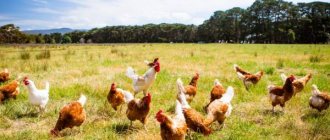Relevance of a business idea: about commercial prospects
When considering any business project, you should immediately pay attention to its relevance and prospects. After all, further success depends on these indicators.
This type of business activity is characterized by quick payback and high profitability. In addition, small starting investments allow novice businessmen to pay attention to this project.
Breeding quails
A business idea for breeding quails can be implemented in two directions:
- egg production and laying hen breeding;
- breeding birds for meat supply.
The choice of direction is largely determined by the competitive environment and the scale of the business. Therefore, the most important point in the implementation of this project will be an analysis of the competitive environment and market.
The best option is to combine these two areas within one farm.
Quail meat has a special delicate taste and is valued all over the world due to its rich set of microelements. The meat of this bird has been valued in Rus' for a long time, but before it was preferred to be obtained by hunting. Later, quail breeding became one of the areas of the agricultural sector.
Dietary poultry meat is considered one of the most easily digestible and contains up to 22% proteins in purified form. The high content of healthy vitamins (A, H, K) and low calorie content make this product a frequent menu in the diet of children, athletes and those who watch their figure.
Features of the technology
But, despite the apparent advantages of the product, competition in the market is not high enough, which opens up great opportunities for budding entrepreneurs.
Pros and cons of the project
Raising birds has many advantages and disadvantages, but each may vary regionally. We tried to average the indicators of the bird breeding process and demonstrate the standard pros and cons.
Pros:
- good payback;
- low costs;
- fast development;
- low concentration of competitors;
- high demand for products.
Low competition is perhaps one of the key points indicating great prospects. Considering the increased popularity of natural products and the general orientation of the whole world towards proper dietary nutrition, the demand for quail eggs and meat has increased significantly. At the same time, it is not able to fully satisfy the market potential that is present on the market today.
Quail business
In this regard, the idea of quail breeding is very promising. In some regions of our country it is even difficult to find farms that breed birds on a professional basis.
Minuses:
- short life expectancy;
- bird disease (influenza, salmonellosis, pullorosis, etc.).
In large-scale production, as a rule, laying hens are kept for up to 11-12 months only to produce eggs for sale. Their eggs are no longer suitable for incubation. In a small farm of 250-300 animals, it is very unprofitable to keep a separate parent flock just for egg production. Therefore, experts recommend replacing birds every 8-9 months. By this time, the next generation should have grown up, ready to produce eggs for sale and incubation.
Large production
As for poultry diseases, at the slightest ailment, farmers get rid of a weak individual so that it does not infect the rest of the flock.
Sales of products
To sell the products that a quail business provides, you need to go around to all potential buyers and talk about the product. At first, it could be family and friends who will help you find clients. Next - trading houses, shops, restaurants, farms. You need to distribute pre-prepared business cards with the company name and contact information. The product can be supplied to one buyer, or you can become a mass supplier and supply various institutions. It all depends on production volumes.
You can create a website on the Internet with the necessary information about the product being manufactured, or print advertisements on sales sites. Another option for disseminating information is to turn to radio or television.
You can sell quail eggs, carcasses, live chickens, and droppings. Selling live animals is more profitable, the cost is the same as processed carcasses, and energy costs are lower. They are bought at any age.
Livestock breeding must comply with technical, sanitary and hygienic rules and regulations. It is mandatory to have an individual entrepreneur certificate and obtain a quality certificate for the products and certificates from a veterinarian.
Breeding technology
Raising quails to sell meat and eggs is an excellent alternative to traditional chicken products. Unlike chickens, quails do not need to build a large chicken coop. It is necessary to equip cages for them.
Based on the calculation of 1 square meter per 50 quails.
With proper balanced nutrition and maintenance, 100 quails per day will lay about 90 eggs weighing up to 13 grams
One of the key requirements for keeping birds is to ensure optimal temperature conditions and sanitary standards of the room (cages). For greater fertility, it is necessary to maintain a constant temperature in the range of 18-20°C.
With a strong drop in temperature (up to 15°C), the bird can significantly reduce productivity and stop laying eggs altogether. If you allow the temperature to drop critically to 7-8°C, then it may even die.
Conditions of detention
In hot conditions, it begins to lose its plumage and also reduces productivity. Therefore, maintaining a constant temperature in the cells is one of the primary tasks. To ensure normal living conditions, it is also necessary to provide a ventilation and cooling system. In winter - heating of shelving cages.
Cell selection
The next point is to select the right cage. Ideally, of course, you would purchase specialized equipment for the farm, but with minimal investment, you can make your own cage.
How to choose the right cage? First of all, it must be made of galvanized mesh or metal. Universal devices will not work here, since the distance between the rods must be clearly calculated for the size of the quail’s head. Birds must freely stick their heads between the bars in order to take food or reach water, but not leave the cage or get stuck.
The height of their “house” should not exceed 20 cm; behavioral factors should be taken into account here. Quails are prone to sudden jumps and a high ceiling can cause head injury.
Quail cages
You should also provide a tray for rolling eggs. Unlike chickens, these birds lay straight on the floor.
To maintain sanitary cleanliness, you need to place a container for litter in the cage.
As for the volume of quail habitat area, there are clear numbers that should not be violated. For every 10 heads, 20 square centimeters of space must be provided. It is interesting that for chickens, a decrease in free space not only does not affect egg production, but, on the contrary, leads to an increase. And in the case of quail, you can get the opposite effect.
Prices for quail cages
Quail cage
Feed requirements
For normal development and effective productivity of females, it is necessary to purchase high-quality food from trusted suppliers.
The simplest step is to purchase ready-made feed. Compound feed labeled PK-5-2, PK-1, PK-6 is suitable for broiler chicks. It contains the necessary amount of protein, which affects the egg production of the female.
Feeding should be strictly on time - three times a day. Depending on the breed, the daily food intake is 22-30 grams.
Compound feed for quails
To increase productivity and gain weight, it is recommended to add nutritional supplements to the main feed. These can be vegetables, fresh herbs, vitamins.
If you thoroughly understand agriculture, you can analyze that almost all feed for birds have a similar composition. The difference is made by grain grinding and food additives. The difference also lies in the periods of introduction of one or another food.
Considering the precocity of quails, purchasing starter feed rich in nutrients is of great importance. This allows a small chick to increase in size almost 15 times in 30 days.
What to feed quails in the first days of life?
Beginning poultry farmers need to figure out how to organize feeding the chicks. You can get a healthy brood by creating a balanced diet. Attention is also paid to the conditions of detention. You will find out what to feed quails in the first days of life by reading this article.
When little chicks appear, the farmer has a new concern - special nutrition for the babies. Feeding is very similar to feeding chickens. In the first days, you can give a hard-boiled egg, which must be thoroughly crushed so that the chick does not choke. After 12-14 days, they can be transferred to a full-fledged adult diet, taking into account the characteristics of the breed.
The starter kit must include:
- grain (wheat, corn, barley);
- cake;
- yeast;
- chalk;
- broken shell, salt;
- meat and bone meal or fish.
Mandatory requirements for food are nutritional value, balance, fine grinding.
Prices for grain grinder
Chopper for crushing all types of feed grains and seeds
Feed composition
Newly hatched chicks need to be provided with up to 25% protein in their feed for 30 days. Starting from the second month, this figure drops to 16%. For laying hens it is about 20%.
This is why experts recommend feeding chicken starter kits for at least 30 to 40 days. And only after that switch to food for adult birds.
As for the feeding process, it is important to choose the right drinkers and feeders for small birds. Given their light weight, the edges should be low.
Nipple drinker for quail
To minimize costs, you can save on preparing feed with your own hands. This can reduce ration costs by almost three times. An additional advantage will be that you will add the necessary microelements and additives yourself, depending on the health of the birds and the conditions of their keeping.
Quail food
Food for quails can be factory-made or prepared independently, but one thing is important - the correct composition. In our article you will find recipes for compound feeds, varieties of ready-made feeds. You will also find out which feed is better: store-bought or home-made?
Premises requirements
The room can be used small, with an area of 15 m2. It can be found at home or built specially. They provide an additional source of power supply, heating, and ventilation.
A separate room will be needed for incubation, raising young animals, and storing feed.
Humidity 60-70%. Keeping it in dry air causes feathers to become brittle. At the same time, the birds' beaks are constantly open. To increase humidity, wash the floors and place dishes with water in the room.
Once a week, bowls of sand and ash are placed in the cages. Birds “bathe” in them, getting rid of lice. After the procedure, the sand is checked to ensure there are no eggs there.
You can keep quails at your dacha in the summer , but in this case they will be sold by winter. Otherwise, you need to heat the room in the fall.
It is possible to keep quails in winter without heating, in an insulated room. But they won't lay eggs until spring.
When creating industrial production, the premises for raising birds should be located at a distance of 300 m from residential buildings.
There should be no busy roads nearby, no strong music playing, or no construction site. Otherwise, the birds will be nervous, grow poorly and lay eggs. Sparrowhawk device. Personal experience:
Choosing a breed
Initially, this bird was wild, but as a result of long-term selection, it gradually acquired the status of a domestic bird. Today, experts count about 40 different species, each of which has its own characteristics in terms of content and productivity.
Quails of various breeds
Experts classify quails for breeding according to the following criteria:
- meat breeds;
- meat and eggs;
- egg.
Whichever option you choose, they are all productive and lay well in any case. Another thing is that for selling meat it is better to select special breeds, for example Pharaoh, which quickly gain weight.
Choosing a quail breed is the most important step in planning, because all further success and profit will depend on this.
Quail breeds
Looking ahead, we should note the most common breeds in Russia:
- Pharaoh;
- Japanese quail;
- Marble rock;
- Tuxedo;
- Estonian quail.
Japanese is especially loved among domestic farmers, as it is the least demanding of its conditions and is characterized by increased immunity.
Japanese quail
Meat breeds
A feature of this type is rapid weight gain. With proper care and a balanced diet, which must contain useful microelements and vitamins, birds of this type gain up to 300-500 grams of weight.
Pharaoh
It is one of the most common meat types. It is not very productive and lays about 180-200 eggs per year. Adult individuals reach up to 300-330 grams of weight, which explains their great popularity not only in Russia, but also abroad.
Pharaoh
Texan (American)
Because of its white plumage, this bird is often called the Texas albino. This breed is one of the best for breeding as a meat supply, as adult individuals reach a weight of 400 grams. As for productivity, females are not distinguished by high egg production, however, like all broilers. They produce up to 200 eggs per year.
The downside is the large volume of feed consumption, which significantly reduces profitability.
Texas white
Egg breeds
If in business activity the main emphasis is on the sale of eggs, then, of course, it is better to give preference to the purchase of birds of this species. They are highly productive and allow you to produce up to 300-350 pieces per year.
At the same time, females begin to lay eggs from an early age, from 1-1.5 months, which increases the productivity of the business process.
The most popular breeds in this type are:
- Estonian;
- Manchurian golden;
- Marble.
Manchurian gold
Marble
Meat and egg breeds
As the name itself suggests, this is a fairly versatile variety that is often purchased for household use. If you are planning to set up more specialized production, then experts still recommend purchasing egg and meat breeds separately.
The most popular in this species are English White quail, English Black, Tuxedo. As a rule, the name of the breed determines the color of the plumage.
English black
Tuxedo
Diseases
Quails are less susceptible to diseases than other poultry. But this does not mean that you can neglect the rules of keeping and caring for birds; you must take care and provide decent maintenance for quails so that diseases do not affect your flock of birds. Good care and proper maintenance of poultry is a prerequisite for a profitable quail business. There are no preventive vaccines against avian diseases, so the owner must ensure full compliance with sanitary standards in the poultry house. Quail chicks react negatively to any changes, worsening weather conditions and sudden temperature changes are destructive for them. If young animals are exposed to these negative factors, then diseases and deaths cannot be avoided. Here are some of the most common and dangerous:
- Coccidiosis: A very dangerous disease caused by parasites from protozoan groups. Chickens are more often affected by this disease, but quails are also susceptible to infection. Treatment involves suppressing parasites in the blood of chicks and adults. The most common medications to combat coccidiosis are statil, decox, coyden, coccidin, zoalen, bichonolate, amprolium, chemicalcoccid-17, ardinone-25, avatek, sakox, rigecostat, baycox.
- Ulcerative enteritis : treated with feed antibiotics (bacitracin, lincomycin, avoparcin, nitrovin), as well as drinking antibiotics (oxytetracycline, penicillin, erythromycin, amoxicillin, metronidazole, tylosin). Afterwards, take a course of prebiotic drugs.
Eggs or meat?
The meat of these birds is considered dietary and one of the healthiest, as it contains a large amount of protein and a low percentage of fat. In addition, it contains practically no cholesterol, which makes it indispensable in the menu of pregnant women, children, people suffering from high blood pressure, diabetes, etc.
Daily consumption of quail meat normalizes cholesterol levels and strengthens the immune system.
Quail eggs
As for eggs, it is because of them that farmers often start breeding quails. Unlike other domestic birds, quail eggs can be eaten raw without fear of contracting infectious diseases. This is explained by the high body temperature of females (about 42°C), which eliminates the possibility of poisoning and bacterial growth.
A feature of birds is rapid puberty and early laying of eggs. Let's say, if the laying age of a chicken starts at 8 months, then here it is reduced to 1-1.5 months.
Quail eggs
Interesting! The benefits of quail eggs are proven by the fact that, for example, in Japan, pediatricians recommend that each schoolchild eat 2 eggs before classes. This has a beneficial effect on the nervous system and improves the perception of information.
It is important to immediately decide on the purpose of breeding
Having weighed all the pros and cons of each breed, it is important to clearly determine for yourself the purpose for which you plan to breed birds. After all, it is the choice of format and method of marketing that will determine the purchase of a certain type of bird.
As for calculating the benefits from the sale of eggs and meat, you need to clearly calculate the income at the planning stage.
Selling eggs
If you sell only eggs, then the poultry house is unlikely to pay for itself quickly.
Preparing for sale of quail eggs
Let's do the math. The average quail lays about 20 eggs per month. One egg on the market costs 5 rubles. The monthly income from one bird will be 100 rubles. With a livestock of 500, the income from the farm from the sale of eggs alone will be 50 thousand rubles. But this is only income, not net profit. Take away transportation costs, utility bills and staff salaries from here and you will not get such a large amount.
And if you add all sorts of risks in the form of infections of laying hens, stress, which negatively affects productivity, then this income can even be halved.
Another form of business is the sale of eggs for incubation.
Equipment
A business plan for raising quails must include the costs of purchasing and installing equipment. At first, you will need to purchase:
- cage batteries equipped with drinkers, feeders and sloping sides for collecting eggs;
- automatic air conditioning system;
- outlet chamber;
- an incubator with the ability to maintain a temperature of about 38 ° C and humidity - 50-90%.
DIY cages
For those who want to save thousands of rubles, there is an excellent option - making bird cages by hand. All materials can be found in any market at affordable prices. You will need:
- plywood or fiberboard;
- net;
- cardboard for the ceiling.
When designing cages, keep in mind that their height, as well as the size of the cells, depend on the purposes for which you will use the products. There are six types of “houses” for quails - each of them is best suited for keeping:
- chicks from birth to ten days of age;
- young animals (10-45 days old);
- adult birds;
- individuals laying food eggs;
- parent pack;
- birds fed for meat.
You can find detailed instructions and drawings on the Internet or ask your colleagues in the workshop. By the way, if you have never raised quails, the advice of a veterinarian will be very helpful at first. After all, as soon as you place pets in unsuitable cages, the consequences will not keep you waiting: it will become more difficult for birds to clean their feathers and gain weight, and the chicks may even die immediately.
Business plan: where to start?
As in any other type of business activity, you should not immediately invest all your money in purchasing live heads. Experts recommend starting with 300-500 quails and then gradually increasing the number of quails.
The purchase of a certain number of heads significantly affects the cost item, which will change the payback period. We give average values of 500 heads.
Purchase of quails
It is also important at this stage to correctly determine the format of the business, because you can breed birds for sale of live heads, eggs or finished meat. In addition, you should immediately decide whether you will buy adults or hatch the chicks yourself using an incubator.
Documents for opening a farm
To open a case, you need to prepare the following documents:
- it is required to register an individual entrepreneur (individual) or LLC (legal entity);
- it is necessary to obtain permission to open a business;
- obtain a certificate of conformity for the product (after laboratory testing of the product) - issued by Rostest;
- special barcode (issued by Rostest);
- obtaining specifications for products (issued by research institutes) - needed for each type of product (meat, eggs);
- When dealing with customers, agreements for the supply of the product should be concluded.
These papers are required for large-scale sales to retail chains and the regional market. Fewer documents will be needed if you are planning a private subsidiary plot (personal subsidiary plot). A veterinary certificate is sufficient for the sale of products. It can be sold to resellers, in small markets, using mobile shops.
Organizational plan
This section of the document allows you to plan your activities step by step. Thus, the document becomes a desktop guide that allows you to complete tasks in a timely manner and calculate risks.
Business registration
The first stage of doing business is, of course, the registration part. It is necessary to obtain a business permit and a license to sell products.
Choose the most suitable form of business for yourself - LLC or individual entrepreneur - and submit documents for registration.
With a small turnover, it will be enough to register an individual entrepreneur and a form of payment for the Single Tax. Registration will not take much time.
Individual entrepreneur registration
To sell products, it is necessary to obtain certificates from the veterinary service. Without this, you will not be able to enter into contracts with large suppliers and sell products to restaurants, cafes and shops.
Required premises
As mentioned above, in terms of content, these birds are not very whimsical. Therefore, choosing the right room will not be difficult.
Here, first of all, it is necessary to focus on the size of the livestock and the technical nuances that will allow maintaining optimal temperature conditions.
Quail farm
To maintain a community of 500 animals, a farm of 20 square meters will be enough. It is recommended to separate zones for chicks and parent flock. Allow no more than 4 square meters for chicks, 3 square meters for the incubator, everything else for adults.
Requirements for conditions of detention:
- temperature – from 18 to 25°C;
- humidity – within 68-70%.
Room
What kind of personnel is needed to breed quails?
The success of any business depends not only on the proper organization of the premises, but also on the selection of good specialists. To breed birds, you need to hire several people to work.
Of course, at the first stage, to minimize costs, you can independently perform all the duties of caring for the birds. But for large-scale farming, you cannot do without helpers.
You need to hire a person who will clean the cages, remove garbage, pour food and pour water.
It is also important to constantly monitor the health of the birds and the incubation process. In addition, there must be someone responsible for selling products, negotiating with suppliers, etc.
Staff
For a farm of 400-500 birds, two people will be enough.
The approximate staffing looks like this:
- bird care specialist;
- driver/courier.
It is unprofitable to hire a veterinarian separately. The best option is piecework payment and calling a specialist if necessary
Equipment for quail farm
Immediately think about a ventilation system that will bring in fresh air from the street. In no case should there be drafts in the room, so the option of natural ventilation should be immediately excluded.
Primary requirements
Another feature of keeping these birds is the creation of dim light. Both in the wild and when kept at home, birds do not like bright light. Therefore, give up powerful lamps and give preference to economy lamps with shades.
This, by the way, is another advantage that speaks to the cost-effectiveness of the business. After all, keeping chickens or ducks, on the contrary, requires bright lighting, which significantly increases energy costs.
If the number of livestock is 500, in winter it is necessary to consider a heating system. This point can be omitted only if the farm is designed for a thousand or more pieces. Then the bird warms itself, and there is no need to artificially heat the farm. You just need to take care of high-quality insulation of the walls and roof.
The main components of the farm equipment are cell batteries.
Cage batteries at a poultry farm
One battery consists of 5 cells and contains an autonomous feeder, drinking bowl, and a tray for eggs that roll out.
The cages are located at a slight angle, which ensures quick collection of eggs.
One battery can hold up to 250 individuals. They can be ordered ready-made, or you can save money and make them yourself from metal reinforcement, mesh and plywood.
Incubator for breeding chicks
The next point of purchase of equipment will be an incubator for hatching chicks. Today there are a large number of different models from domestic and foreign manufacturers on the market. For home use, of course, the simplest model is also suitable, where you mechanically set the temperature, humidity, and turn the eggs.
Quail incubator
Breeders are increasingly thinking about breeding quails. And the first step to success is breeding full-fledged chickens in home incubators. You can buy a quail incubator or make it yourself. We will talk about this in this article.
For large production, it is better to give preference to modern models with automatic egg turning mode, maintaining temperature, humidity and the ability to work on an autonomous battery during a power outage.
Incubator
So, to organize a medium-sized quail farm, you will need:
- incubator – 10 thousand rubles
- battery of cells – 10 thousand rubles.
- brooder (nursery for chicks) – 2 thousand rubles.
Quail brooder
The presence of a brooder greatly simplifies the care of chicks and increases productivity in the flock. In our article you will find the basic requirements for a “nursery” for chicks and how to make a brooder yourself.
Chick
If you plan to expand the scale and service in the future, you can immediately purchase:
- grain mill for self-production of feed;
- automatic feather plucking machine;
- vacuum sealer (increases the shelf life of meat);
- refrigerator and freezer.
Prices for egg incubators
Egg incubators
Starting purchase of birds
After the premises have been selected and all repair and construction work has been carried out, personnel have been selected and equipment has been purchased, the stage of purchasing birds begins.
Having decided on the number of livestock and the breed of birds, it is important to find a good and trusted supplier. Experts do not recommend purchasing all livestock from one seller at once. It is better to divide the purchase into 2 parts and see which of the birds will be the strongest and most fertile. If necessary, you can always purchase the number of pieces you need.
Purchase of birds
The suitable age of quail for purchase is no older than 12-18 months. It is at this age that the young female reaches sexual maturity, which means she is ready to lay eggs.
If for the purchase of chickens, ducklings and other birds there are recommendations on the time of year for purchase, then with quails things are simpler. The productivity of females does not depend in any way on the season, and the farmer creates the necessary conditions for hatching eggs himself.
Quail in the nest
An important point: before purchasing livestock, you must consult the seller about the type of feed that the birds were previously fed, and try not to change it. A change of place of residence, and especially of diet, can dramatically affect the health and reduce the productivity of females.
If you plan to transfer the birds to their own food, then this should be done gradually, no earlier than a month after relocation.
Is it really possible to make money on quails?
Why are you going to breed quails: for yourself or to earn money? Why am I asking this question? Almost every farmer can start growing quails, but not everyone can make money from it. There is a lot of information on the Internet about how to set up a room for quails, how to create conditions for keeping birds, where to buy cages and young animals, etc. But there is almost no information on how to profitably sell quail products, and this is the most important thing. Before you set up a room, spend money on purchasing cages and food, make sure you can sell everything you plan to grow. Have you, as a consumer, ever bought quail meat or eggs? (and not everyone does this). For example, chicken meat is very popular and raised chickens can be sold even to friends. But with quails, I’m afraid this trick won’t work. Your clients will most likely be restaurants, cafes (and those serving exotic foods), grocery stores and specialty markets. But keep in mind that not everywhere they will be waiting for you with open arms. At first, you can’t even dream about retail networks; there are enough players there even without you. So, don’t be lazy to first study the sales market, and only then can you begin the practical part of creating a farm.
Marketing plan
This section is the most important planning stage. It allows you to adequately assess the market situation, analyze the competitive environment and correctly determine pricing.
Sales channels
Even at the stage of searching for premises and purchasing equipment, it is important to determine distribution channels. Depending on the business model (sales of meat, eggs, chicks), it is necessary to think about who will buy the products in bulk.
Considering the active productivity of quails and the short shelf life, you must be confident in well-established sales.
Fresh carcass
How to look for clients?
- Analyze the market and identify the main competitors in the region close to you.
- Study their products, prices, sales form.
- Create a commercial proposal and send it (or personally deliver it) to the managers of cafes, restaurants, supermarkets, and shops. Visit fairs, markets, etc.
Remember that the quail breeding business requires the same advertising promotion as any other area. You should not rely solely on the “word of mouth” effect. Firstly, this effect is achievable after a year or two. Secondly, it will not be possible to develop a large business with prospects this way.
Purchase of feed and livestock
There are several ways to acquire livestock:
- Purchase of hatching eggs (price for egg breed - 15 rubles, meat - 20 rubles). Approximate costs: 1000 eggs for 20 rubles. (total 20,000 rubles) + incubator + brooder for young animals + payment for electricity + purchase of compound feed.
- Quails aged 1 day (cost - 40 rubles). 1000 Heads will cost 40,000 rubles. + electricity + brooder + purchase of feed.
- Quail at the age of 50 days (150 rubles). It turns out the cost is 150,000 rubles.
Looking at all the options, it is clear that in the first two cases, in order to raise 2 month old individuals, a lot of time, money and effort are spent. Option 3 is optimal, since the poultry farmer immediately receives sexually mature individuals.
Food for quails must be of high quality; the growth of the pet depends on it. But feed made specifically for them is expensive, so chicken feed is often used; it is not inferior in quality to quail feed. The diet includes vitamin supplements, finely chopped vegetables and herbs, eggshells and shells to replenish calcium. The water in the drinking bowls must be fresh and in sufficient quantity. Quails need to be fed in accordance with the norms; you should not overfeed, as this will lead to obesity.
Feeding Basics
The diet for quails must be complete and aimed at the purpose of breeding the livestock. It varies and is compiled depending on the direction of growing quails. In addition to special feed, you need to feed crushed corn and wheat. In summer they give finely chopped grass, vegetables, and fruits. Each cage must have a drinking bowl and a feeder. An obligatory component of the diet is crushed shells or shells.
In summer, especially in the heat, it is important to monitor the freshness of food and the availability of plenty of fresh water. Remains of food are removed to prevent rotting and poisoning of the quail.
Financial plan
This is one of the most time-consuming sections of documents, which reflects the entire financial essence of the project. Here it is necessary to correctly assess the risks, calculate costs and income, determine the break-even point, payback and profitability of the project.
When detailing the costs, it is important to understand that the main part will be the purchase of materials for the construction of the farm, repairs (if a ready-made premises is purchased).
Income and expenses from the quail business
This should also include the purchase of birds, feed, staff salaries and business registration costs.
When calculating profits, you should correctly determine the cost of production. Don’t forget that it includes not only the purchase of the poultry itself, but also its maintenance, food, utility costs, transportation, specialists’ salaries, etc.
The same goes for profitability. It is important to separate one-time expenses, which may include the purchase of equipment, construction or repair of a farm. And there are also fixed expenses in the form of salaries, utilities, advertising, etc.
Expenses
All costs of maintaining a farm can be divided into two types:
- capital (one-time);
- monthly.
Based on this, we draw up an estimate.
Capital Expenditures
| Cost item | Amount, rubles |
| Total | 90 000 |
| Paperwork | 10 000 |
| Purchase of chicks (500 pieces) | 15 000 |
| Construction of a poultry house | 20 000 |
| Purchase of equipment (lamps, ventilation) | 10 000 |
| Buying an automatic incubator | 20 000 |
| 10 000 | |
| other expenses | 5 000 |
Monthly expenses
| Cost item | Amount, rubles |
| Total | 45 000 |
| Purchase of feed | 10 000 |
| Public utilities | 5 000 |
| Staff payment | 25 000 |
| Fare | 5 000 |
Calculation of profitability and profitability
In order to correctly calculate the profitability and profitability of a business, it is necessary to separate the sale of eggs, meat and live poultry.
Selling eggs
We calculate the proceeds from the sale of eggs:
Above, justifying the idea of breeding quails for the sale of eggs, we said that one bird lays about 20 eggs per month. But not all eggs from females will be sold. To increase the farm, approximately 1/3 must be set aside for incubation.
Thus, the income from the sale of eggs will be 200 quails * 20 eggs * 5 rubles = 20 thousand rubles.
The female eats 900 grams of food per month for 20 rubles. 500 females * 20 r = 10 thousand rubles will be spent on food.
Sale of carcasses
We calculate the revenue from meat trade:
1 carcass weighing 250 grams costs 100 rubles.
100 carcasses sold per month.
100*100r = 10 thousand rubles.
Conclusion: based on the document compiled and calculation of the financial part, the average payback period will be 5 months. The poultry house will generate income in the amount of 35-40 thousand rubles.
In order to increase volume and expand production, you can invest in new equipment and expand services and sales market.
Practical advice for a beginning farmer
- You shouldn’t immediately invest all your money in purchasing young animals.
- You should purchase eggs for incubation and young animals from trusted suppliers, preferably two or three.
- When raising quails, you should not rely only on selling eggs or meat. A universal approach will increase profitability.
- To minimize personnel costs, some specialists can be invited from outside if necessary. The main part of the work will have to be undertaken at the first stage.
- Selecting the right equipment. Given the miniature size of the birds, the cages should not be high.
- Maintaining a constant temperature within 18-25°C.
- The farm does not require large sizes and can easily be placed in a barn or room. The only caveat is that you need to provide ventilation and an influx of fresh air, but at the same time avoid drafts.
Practical tips for breeding quails











